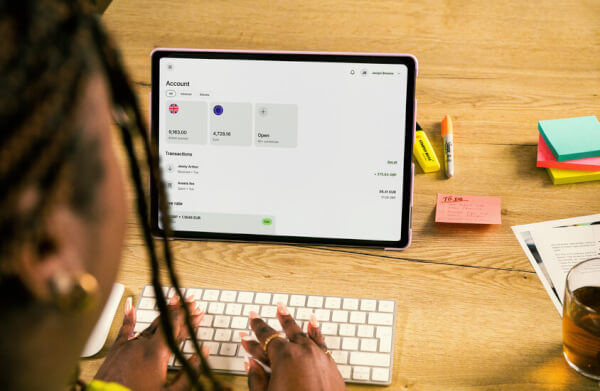Managing Remote Working like a Pro
Remote working has never been more popular. Driven by necessity during the recent pandemic, the trend for flexible, home and hybrid working now looks like...

Doing freelance work for a client abroad? If so, this guest post by one of our customers, a freelance writer from Ireland, could help you avoid hidden charges and save you more than £10 for every £100 you earn. By Susan Connolly
Although I do a lot of freelance work with clients in the UK, I live in Ireland and use euros. Unfortunately, my clients have no interest in being billed in a foreign currency.
When I first started to bill for my work in pounds, I used a quick fix to estimate my payout: (1) go to XE.com to check the most current rates, (2) plug in my payment figures, and (3) assume that I’d receive the amount shown.
Whoops, not even close.
Let’s look at an example. So, today is invoicing day, and I’ve got two UK clients to bill--one for £100, and another for £1,000. How many euros should I actually expect to receive?
The exchange rate given by XE.com is £1 = €1.26507.
At this rate, £100 should get me €126.51, while £1,000 should get me €1,265.07.
Unfortunately, XE.com gives its quotes using the mid-market rate, but this is not even close to the rates that banks actually offer you. Even when a bank says that they don't charge a fee for foreign currency exchange, they're still making money by using an exchange rate that’s marked up substantially.
Let’s see how much I’ll actually receive in this example by looking at some popular currency transfer services:
PayPal is at least transparent about how they calculate their “exchange rate,” which they describe as “the wholesale cost of foreign currency … plus a currency conversion fee.”
Yet finding out what that exchange rate actually is, however, requires you to do a bit of work. In fact, you can’t even estimate your payout without having an active account.
First, my client would send the invoiced amount of pounds sterling into my PayPal account. After this transfer,
£100 becomes £96.40, £1,000 becomes £964.00**Note that no currency conversion has actually happened yet--the fees taken out so far are just service fees for the privilege of using PayPal. Next, I use PayPal’s “Balance Conversion” tool to see the results of the currency conversion.
My £96.40 becomes €119.20, around €7 less than the €126.51 I was expecting. My £964.00 becomes €1,189.86, a whopping €75 less than the €1,265.07 I was expecting. PayPal’s not looking so friendly, after all.
According to a major high street bank (let's call them "Lloyds”), my freelance clients will have to pay a £10 fee to send me an online bank transfer under £5,000.
Not a good start, as there is already a £10 fee on each transfer before it hits my account. "Lloyds" will also use their own exchange rate.
Today, they quoted me a conversion of £1 = €1.23724. That means, after taking away the £10 fee:
Unlike these other services, Wise actually uses the mid-market rate in their conversion. Also, their fee is clearly presented and very easy to understand: it's £2 for amounts of £400 and under. If I'm moving more money than that, they charge a 0.5% fee.
With Transferwise, my international payments get far closer to what I was lead to expect by looking at the mid-market rates on XE.com.
£100 gets me €123.98
£1,000 gets me €1,258.74
Plus, even though my home bank account is in euro, I could've saved myself all the trouble by directly getting paid the amount in pounds to my Wise borderless sterling account.
Once I signed up for my Wise multi-currency borderless account and got verified online, I was all set. I just generated local UK bank details in one click so my clients could pay me locally.
I got so much control back. Once the exchange rate was right, for a small fee I could either transfer the sterling from my borderless account straight to my home bank account, or switch the pounds for euros inside my borderless account and kept it there to spend at will.
The Real Cost of Currency Transfer (Or, How Much Money I’ve Thrown Away...)
| Service | What I’d Get for £100 | Real Fees | Loss from mid-market rate |
|---|---|---|---|
| Wise | €123.98 | €2.53 | 2.00% |
| PayPal | €119.20 | €7.31 | 5.78% |
| Euros from UK Bank | €111.35 | €15.16 | 11.98% |
| Service | What I’d Get for £1000 | Real Fees | Loss from mid-market rate |
|---|---|---|---|
| Wise | €1,258.74 | €6.33 | 0.50% |
| Euros from UK Bank | €1,224.87 | €40.20 | 3.18% |
| Paypal | €1189.86 | €75.21 | 5.95% |
Three Vital Takeaways
1) Always Look At The Numbers Carefully:
Fees aside, exchange rates are incredibly important in deciding how much to charge for your services. I was throwing money away by not properly considering them in my pricing.
2) Whenever Possible, Bill Big:
Generally, the lower the amount of a single invoice, the bigger the hit from exchange rates and fees. That's due to charging of flat fees during the exchange process. If you’re billing a client weekly, try to switch to monthly invoices. For small batch and occasional jobs, increase your rate accordingly.
3) Use Wise Business:
As you can see, Wise crushes the other options for both amounts, maximising my income and giving me more money to play around with at home. There’s no doubt about it: freelancing can be an awesome way to work. But you can get in trouble quickly if you don’t pay attention to your bottom line. Don’t make the same mistakes I did--weigh your money transfer options carefully.
What are some of your biggest freelancing blunders? Help the community by posting below so we can learn from your mistakes!
*Please see terms of use and product availability for your region or visit Wise fees and pricing for the most up to date pricing and fee information.
This publication is provided for general information purposes and does not constitute legal, tax or other professional advice from Wise Payments Limited or its subsidiaries and its affiliates, and it is not intended as a substitute for obtaining advice from a financial advisor or any other professional.
We make no representations, warranties or guarantees, whether expressed or implied, that the content in the publication is accurate, complete or up to date.

Remote working has never been more popular. Driven by necessity during the recent pandemic, the trend for flexible, home and hybrid working now looks like...

Getting paid by international clients as a freelancer can be tricky. Check out our guide to learn the best ways to get paid from abroad without losing on fees.

Essential advice for freelancers in Singapore, covering taxation and best practices for managing your finances effectively.

Freelancing and want to know which freelancer platform to choose - read our review of Upwork to help you decide.

There are three ways to withdraw money from Fiverr; the first two methods are provided by Payoneer, while Paypal provides the third method.

work from home jobs. customer service, writer, editing and proofreading, software engineering, web design, product design.